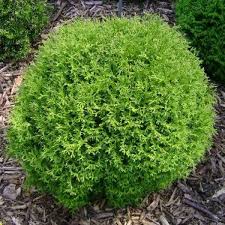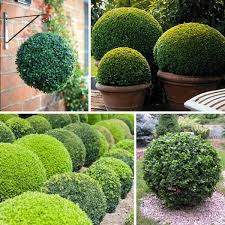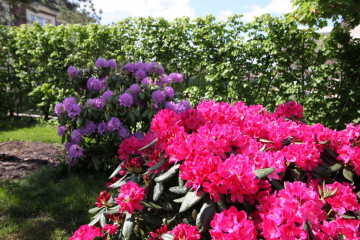Thuja - planting and care outdoors in spring
Content:
Translated from the ancient Greek, thuja means "tree of life". Why is it so attracting the attention of biologists, doctors, designers, perfumers and ordinary gardeners? First of all, it is an adaptation to the environment. Thuja can grow in swamps, in valleys, along the banks of mountain rivers; it adapts well to soils rich in limestone and poor podzolic soils. In addition, this tree lives for a long time, its age can exceed its three hundredth anniversary. In Europe, thuja has been known since the 16th century, and in Russia it was first planted at the beginning of the 19th century. in the Crimea, in the Nikitsky Botanical Garden. The first admirers appreciated not only its fabulous beauty, which is preserved all year round. The needles contain essential oils that have long been widely used in medicine and perfumery.
Features and types
Thuja belongs to gymnosperms of conifers from the Juniper family. This genus includes cypress, sequoia, taxodium. Plants of this genus live up to 150 years on average, but sometimes more.
Thuja is represented by trees and shrubs. Young plants have soft, needle-like needles of a pale green color, and adults have scaly, rich green. The fruits are small, oblong cones with flat seeds. They ripen in the first year.
All varieties are subdivided into five types:
- western thuja is the most common cone-shaped species. Unpretentious and winter hardy, suitable for gardening. Has many shapes and varieties;
- folded thuja. It tolerates winter worse, young shoots freeze slightly during cold weather, but gradually the needles are restored;
- eastern thuja is suitable for southern regions. In the Middle Lane it is necessary to cover it;
- Japanese thuja. Prefers mixed forests or mountains. Frost-resistant, unpretentious, withstands long periods of drought;
- Korean thuja is a shrub with a spreading crown with spreading branches and soft needles, undersized. The second name is creeping thuja. It is planted only in the southern regions.
How to grow thuja: reproduction
Thuja propagation occurs both in the usual vegetative way and by seeds. It is not difficult to grow it, but you should not neglect the planting rules. Varietal plants are usually propagated only in a vegetative way, to which biologists refer to the division of the bush and cuttings.
Propagation by cuttings
Cuttings are prepared in June from woody 2-3-year-old stems. Semi-lignified stems of the current year are also suitable. Cuttings must be carefully torn off with a heel, treated with a solution of heteroauxin. The cutting should be planted to a depth of 15-25 cm. The composition of the required soil mixture: peat, turf soil and sand in a ratio of 1: 1: 1. Everything is spilled with a potassium manganese solution. For the cutting, a microgreenhouse effect is created by covering it with plastic wrap. Airing and hardening is possible only after complete rooting.
Seed propagation
This is a lengthy process that takes 3-5 years.Only freshly harvested seeds are sown and stratified. The seeds are refrigerated in the fall, where they are kept until spring. Sowed in open ground to a depth of 0.5 cm in a shaded place. A thin layer of sawdust is poured on top, better than conifers.
Care must be taken to ensure that the soil is loose, moist and protected from direct sunlight. When shoots appear, the bed should be mulched with peat and spilled with mineral fertilizer once every 2 weeks. Young growth, which has grown by winter, is again covered with spruce branches and foil. Sprout care is resumed in the spring.
Thuja: planting and care in the open field
Thuja can be planted both in spring and autumn. But spring is preferable (from April 20-25 to May 15-20), since over the summer the root system of the young shrub will get stronger, and they will not be afraid.
How to plant thuja in open ground in spring
After choosing a place, a hole with a diameter of about 1 m is dug. The root system of the seedling should fit in the hole so that 15-20 cm remains to the bottom. The soil is poured onto the bottom, mixed with a small amount of compost or rotted manure. Sod land with the addition of sand and peat is also suitable.
The seedling is installed in the center of the pit, the root system of the thuja is straightened, the pit is filled with prepared soil mixture.
If the plant is large, then the root system from the pot is taken out with a lump of earth and lowered into the hole. The root neck of the thuja should be above ground level. Then you should carefully tamp the ground around the seedling, pour abundantly with water, adding root to it. After absorbing the liquid, a layer of mulch (compost, peat) should be poured over the soil for additional protection of the root system on unfavorable days. Planting a thuja in the spring is more favorable for its growth and formation.
How to choose ready-made seedlings, or why it is better to contact nurseries
You need to buy thuja with a closed root system in a container. It can be an earthen lump wrapped in burlap. The plant should not have peeled bark, damaged shoots and signs of disease. Planting and growing a seedling will be easier if you buy it in special nurseries where the care is done by professionals. You can also get step-by-step instructions on boarding right there.
It is best to grow thuja from a small plant, as it takes root better. Depending on the variety and climate, columnar thuja can grow by 1-1.5 m in 5-6 years. Dwarfs grow more slowly. An important condition is to fertilize correctly.
Fast-growing varieties are in special demand:
- Brabant. Columnar thuja, which annually grows 25-35 cm in height and 7-15 cm in breadth. She has large carved needles of a malachite shade. It is frost-resistant, fast-growing, often used in landscape design;
- Golden Brabant. Her needles are golden;
- Columna. Narrow columnar crown, annually adds 30-40 cm upward and about 5 cm in breadth. Scaly needles. Winter-hardy variety;
- Fastigiata. Columnar and fast growing. The crown is narrow-conical and columnar. Growth is about 30 cm in height and 5 cm in width. The needles are dark green, soft with a resinous aroma. Cold resistant;
- thuja folded, or giant.Adds up to 25 cm per year. The needles are dark green, shiny, white spots are visible on the underside. It has a pungent coniferous aroma. Winter hardy, but does not tolerate heat;
- Smaragd is a type of western thuja. She has a narrow-conical shape, dense dense crown. The variety is frost-resistant and shade-tolerant.
Thuja: how to plant and care
How quickly thuja grows depends on caring for it. For young plants, frequent watering, feeding and pruning are very important. The soil of the seedlings must be loosened and weeded. Since the root system is on the surface, weeding should be done carefully around the tree, no deeper than 8-10 cm.
How to feed thuja in spring
In the spring, the plant must be fed with mineral fertilizers. Now on sale there are special balanced liquids designed for certain types of plants, which are diluted with water. The most famous of them are root and aggrecol.
How to cut a thuja and form its crown
Pruning of the plant is carried out in the second year after planting with a powerful pruner. It is best to cut in the summer, when the branches and buds of the bush are finally formed, and it begins to bloom. The next pruning is done at the end of August.
How to cut the thuja correctly? The technology is simple: usually, formation begins when the plant reaches the desired height. No more than 1/3 of the shoot is cut off.
Thuja diseases and their treatment
Most often, trees suffer from the following ailments:
- late blight. Signs: the trunk becomes soft from below, the tree withers, the needles are gray. Reason: moisture stagnates in the soil and does not drain. The root rots. The disease can be prevented by watering with fungicides. Not subject to treatment;
- brown shoots. Signs: yellowish appearance of some of the scales on the shoot. Then they turn brown and die off. Treatment: cut out diseased shoots, feed the tree with limestone and special fertilizers. In the summer, spray with foundation;
- rust and shute. Signs: darkening and falling of the needles. Treatment: treat with a copper-containing fungicide (HOM preparation or Bordeaux liquid). For prevention, cut off and burn all bad branches.
The tree is also attacked by parasitic insects. Most often, the affected thuja turns yellow, many do not know what to do in this case. The reason for everything can be a mottled moth or a false shield, which spoils the aerial part. As part of pest control, you need to spray with karbofos, actellik. Processing is recommended before bud break. Autumn digging helps from insects infecting the roots of the plant, so that there is no stagnation of water.
The most popular use of thuja is to decorate personal plots, squares and alleys. It is one of the most popular shrubs in landscaping. Near the house, both separately and adjacent bushes look great. The graceful crown creates an impenetrable living hedge. In skillful hands, beautiful figures are created from greenery. Do not forget that thuja purifies the air, saturates it with phytoncides. And most importantly, it gives beauty.






















